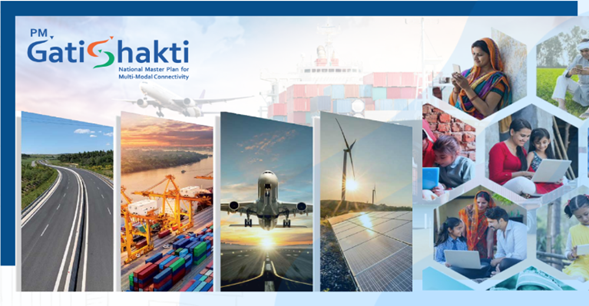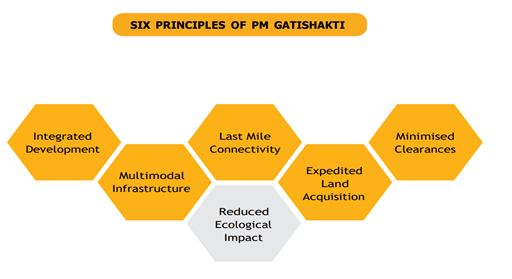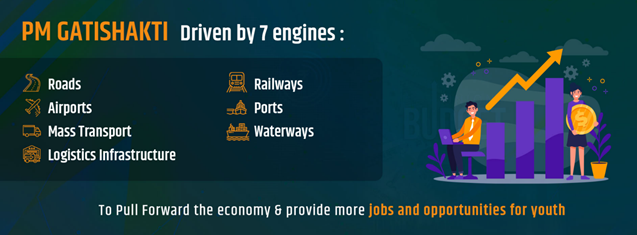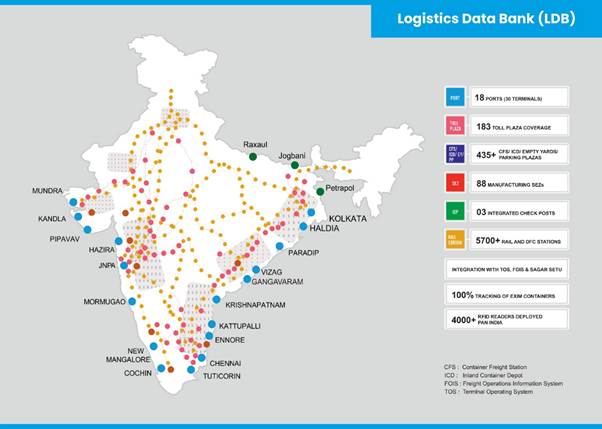On the 75th Independence Day, Prime Minister Narendra Modi announced the ‘PM Gati Shakti’ initiative during his address to the nation from the ramparts of the Red Fort. The National Master Plan for Multi-modal Connectivity, launched on October 13, 2021, is set to celebrate its third anniversary this Sunday. This digital platform is designed to bring various Ministries, including Railways and Roadways, to ensure integrated planning and coordinated execution of infrastructure projects. The initiative aims to provide seamless and efficient connectivity for the movement of people, goods, and services across various modes of transport, thereby enhancing last-mile connectivity and reducing travel time.
PM Gati Shakti incorporates the infrastructure schemes of various Ministries and State Governments such as Bharatmala, Sagarmala, inland waterways, dry/land ports, and UDAN. PM Gati Shakti incorporates the infrastructure schemes of various Ministries and State Governments such as Bharatmala, Sagarmala, inland waterways, dry/land ports, and UDAN.

Gati Shakti: Central Ministries and State Participation
The PM Gati Shakti National Master Plan (NMP) has onboarded 44 Central Ministries and 36 States/UTs and a total of 1,614 data layers have also been integrated. To ensure data accuracy, key infrastructure ministries have finalised Standard Operating Procedures (SOPs) for a three-tier system. SOPs for 8 infrastructure ministries and 15 social sector ministries have been notified, with development continuing for other ministries and States/UTs. A ‘Compendium on PM Gati Shakti National Master Plan’ on data management, prepared by DPIIT, outlines the stakeholder responsibilities.
A ‘Compendium of PM Gati Shakti Volume I and Volume II’ has been developed and launched, that highlights the success stories of PM Gati Shakti. A milestone of assessing 208 big-ticket infrastructure projects worth Rs. 15.39 lakh Crores, of various Ministries adhering to PM Gati Shakti principles has been achieved. Additionally, 434 projects under three economic corridors of the Ministry of Railways have been evaluated and shared with the PMO and they are Energy, Mineral, and Cement Corridors, High Traffic Density Corridors and Rail Sagar.

District-Level Integration
A District Master Plan (DMP) portal is being developed to extend PM Gati Shakti to the district level. This portal will aid district authorities in collaborative planning, infrastructure gap identification, and scheme implementation. A beta version of this portal has already been created for 28 aspirational districts, and user accounts were provided to these districts on September 18th, 2024. Trial runs of the portal are ongoing, with orientation programs in October 2024. The DMP portals for all the country’s districts will be developed in a phased manner and completed by March 31, 25.
Key Accomplishments under PM GatiShakti National Master Plan (NMP)
The PM GatiShakti NMP has resulted in numerous achievements across various sectors, significantly improving project planning, speed, and execution.
- The Ministry of Road Transport and Highways (MoRTH) planned over 8,891 km of roads using NMP, while the Ministry of Railways (MoR) used NMP to plan more than 27,000 km of railway lines. MoR also accelerated the completion of Final Location Surveys (FLS), completing 449 FLS in FY ’22 compared to 57 in FY ’21.
- The Ministry of Petroleum and Natural Gas (MoPNG) streamlined the process for Detail Route Survey (DRS), reducing the time required to create reports from 6-9 months to just one day using electronic DRS (eDRS).
- Using NMP principles, a 13 GW renewable energy project from Leh (Ladakh) to Kaithal (Haryana) achieved optimal alignment of the ‘Green Energy Corridor’ for inter-state transmission.
- Goa used the NMP platform to develop a disaster management plan for flood-prone areas along the Amona River.
- The Uttar Pradesh government employed the State Master Plan (SMP) portal to identify locations for new schools in underserved areas via the Pahunch Portal.
- Gujarat planned its 300 km coastal corridor using NMP, which reduced the number of NoC permissions required for clearance from 28 to 13, enhancing connectivity between four districts while boosting tourism.
- The Department of School Education and Literacy used the NMP portal to link PM Shri Schools with local industries for district-specific skill training.
- The Ministry of Health and Family Welfare identified internet shadow areas and mapped sites for new healthcare facilities using NMP.
- The Ministry of Skill Development & Entrepreneurship utilized NMP to identify suitable locations for new training institutes near economic clusters.
- The Ministry of Rural Development integrated schemes such as PMGSY and PMAY-G for better asset planning and implementation.
- The Ministry of Tribal Affairs identified infrastructure gaps for Particularly Vulnerable Tribal Groups (PVTG) using the PM JanMan portal.
These accomplishments highlight the NMP’s broad utility in improving planning, efficiency, and collaboration across various ministries and sectors.
National Logistics Policy (NLP) 2022: Progress and Key Initiatives
The National Logistics Policy (NLP) was launched on 17th September 2022 to boost India’s economic growth by creating an integrated, efficient, and cost-effective logistics network. The policy aims to reduce logistics costs, improve India’s Logistics Performance Index (LPI) ranking to be among the top 25 countries by 2030, and promote data-driven decision-making. Implementation is driven by the Comprehensive Logistics Action Plan (CLAP), focusing on areas such as digital logistics systems, asset standardization, human resource development, state engagement, and EXIM logistics.
The policy emphasizes training and capacity-building efforts in collaboration with the Capacity Building Commission (CBC). Training modules are integrated with Central and Administrative Training Institutes through webinars, workshops, and digital platforms.

State Logistics Plans (SLPs): 26 States and Union Territories have aligned with the National Logistics Policy (NLP) by notifying their State Logistics Policies to enhance focus on logistics in public policy.
LEADS Survey: The fifth edition of the Logistics Ease Across Different States (LEADS) report was launched in December 2023, with the sixth edition released in January 2024. LEADS assesses logistics ease based on infrastructure and services across States and UTs.
Unified Logistics Integrated Platform (ULIP): ULIP integrates 33 logistics-related systems across 10 Ministries, promoting innovation. Currently, over 930 private companies are registered, with 95 applications made live and 185 companies signing NDAs. ULIP also integrates GST data for end-to-end cargo tracking.

Logistics Data Bank (LDB): For tracking and tracing 100% of India’s containerized EXIM cargo, the Logistics Data Bank (LDB), has been developed. LDB uses RFID technology through the Internet of Things (IoT), Big Data and Cloud-based solutions to provide real-time tracking of EXIM container movement in India. It is a single window, cloud-based logistics visualization solution which provides container movement tracking using only the container numbers; from the Ports to Inland Container Depot’s/ Container Freight Stations; and across the port associated Parking Plazas, Toll Plaza & Railways.
Improving LPI Rank
A dedicated LPI Action Plan has been created, involving multiple ministries (MoRTH, MoR, MoPSW, MoCA) to address logistics challenges across six LPI parameters. Continuous engagement with the World Bank has resulted in discussions on logistics efficiency, reforms, and LPI methodology, along with a national workshop held in February 2024.
The policy incorporates global best practices, collaborating with the Asian Development Bank (ADB) and Korea’s LPI improvement strategies. A round table with the World Bank was held in the U.S. in March 2024 to discuss innovative approaches and logistics improvements for India.
Through these efforts, NLP is driving India towards a more efficient logistics ecosystem while enhancing global competitiveness.
Gati Shakti Sanchar Portal
Universal and equitable access to Broadband services across the country, especially in the rural areas- is one of the most important visions of Prime Minister Narendra Modi. In line with the PM Gati Shakti National Master Plan, “Gati Shakti Sanchar” portal was launched for Centralised Right of Way (RoW) approvals on May 14, 2022.
The Gati Shakti Sanchar portal is a major reform brought in to facilitate faster rollout of telecom infrastructure. It is a Centralised Right of Way (RoW) Portal that enables applicants such as Telecom Service Providers/Infrastructure Providers / Internet Service Providers (TSP/IP/ISPs) to apply for RoW approvals. As on October 11, 2024, 2.11 lakh applications have been approved.
The portal is integrated with all 36 States /UTs and with relevant central ministries viz. Ministry of Railways (MoR), Ministry of Road, Transport and Highways (MoRTH), Ministry of Environment, Forest and Climate Change (MoEFCC) and Ministry of Defence (MoD).
5G services were launched in India on 1st October 2022. More than 13 Cr subscribers have begun to use 5G services, making it the fastest roll-out of 5G anywhere in the world. To further improve telecom connectivity in the country, Government is implementing various schemes.
- A total of 41,160 mobile towers have been sanctioned with an outlay of Rs. 41,331 Cr to
provide 4G connectivity to about 55 thousand villages.
- Scope of BharatNet program has been expanded to connect all inhabited villages with an
outlay of 1.88 Lakh Cr.
Conclusion
The PM Gati Shakti initiative represents a transformative approach to infrastructure development in India, aiming to create a seamless and efficient multimodal transportation network. By integrating the efforts of various ministries and leveraging advanced technologies, this initiative seeks to enhance connectivity and reduce logistics costs across the nation. The Gati Shakti Sanchar portal further supports this vision by streamlining the Right of Way approvals process, accelerating telecom infrastructure rollout, and facilitating the rapid deployment of 5G services across the country. With these combined efforts, India is well-positioned to achieve its ambitious goals of Aatmanirbharta.
 Matribhumi Samachar English
Matribhumi Samachar English


